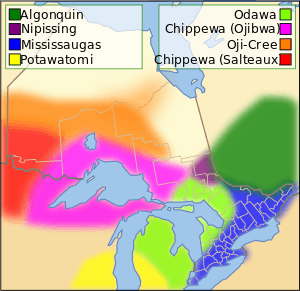Mississaugas

The Mississauga are a subtribe of the Anishinaabe-speaking First Nations people located in southern Ontario, Canada. They are closely related to the Ojibwa. The name "Mississauga" comes from the Anishinaabe word Misi-zaagiing, meaning "[Those at the] Great River-mouth."
History
According to the histories of the Anishinaabe, after departing the "Second Stopping Place" near Niagara Falls, the core Anishinaabe peoples migrated along the shores of Lake Erie to what is now southern Michigan. They became "lost" both physically and spiritually. The Mississaugas migrated along a northern route by the Credit River, to Georgian Bay. These were considered their historic traditional lands on the shores of Lake Superior and northern Lake Huron around the Mississagi River. The Mississaugas called for the core Anishinaabe to Midewiwin meaning 'return to the path of the good life'. The core Anishinaabe peoples formed the Council of Three Fires and migrated from their "Third Stopping Place" near the present city of Detroit to their "Fourth Stopping Place" on Manitoulin Island, along the eastern shores of Georgian Bay.
By the time the French explorers arrived in 1534, the Mississaugas were a distinct tribe of Anishinaabe peoples, living along the Mississagi River and on Manitoulin Island. On the 1675 Carte du Mississippi et des lacs Supérieur, Michigan et Huron, the Mississaugas were recorded as "Missisakingdachirinouek"[1] (Misi-zaaging dash ininweg: "Regular-speakers of the Great River-mouth"). They had moved from the Mississagi River area southward into the Kawartha lakes region. From this location, a smaller contingent moved southwest to an area along the Credit River, just west of modern-day Toronto. The French identified the peoples as Mississauga.
Alternate spellings of the name are Mississaga, Massassauga and Missisauga, plural forms of these three, and "Mississauga Indians". Before the Anishinaabe language replaced the Wyandot language in mid-17th century as the lingua franca of the Great Lakes region, the Mississaugas were also known by the name (exonym) which the Wendat called them.
When Conrad Weiser conducted a census in Logstown in 1748, he identified the people as Tisagechroamis, his attempt at conveying the sound of their exonym, name in Wendat. Other variants of the spelling were Tisagechroamis, Tisaghechroamis, Tisagechroan, Tisagechroanu, and Zisaugeghroanu. "The Tisagechroanu were the Mississagas from Lake Huron, a large tribe of French Indians, or under French influences. The name Tisagechroanue here is probably a misprint, for it is most often found Zisaugeghroanu."[2]
In the waning years of the American Revolution, starting in 1781, the British Crown purchased land from the Mississauga in a series of transactions that encompassed much of present-day southern Ontario. They wanted to make land grants to Loyalists who left property in the Thirteen Colonies to reward them for loyalty, and the Crown also wanted to develop this area of the country with farms and towns. In the 21st century, the Canadian government awarded the Mississaugas of the New Credit First Nation nearly $145 million in settlement of a land claim because of the Crown's underpayment in the 18th century.
Legacy
- The city of Mississauga is named after the Mississauga
- Western and Eastern massasauga rattlesnake (Sistrurus catenatus) are named after them.
- Fort Mississauga is named after them.
Today
Historically, there were five First Nations that made up the Mississauga Nations. Today, the six Mississauga nations are the following (listed under their historical counterpart, if applicable):
- Mississauga First Nation — Mississagi River 8 Reserve
- Mississaugas of Chibaouinani (historical)
- Alderville First Nation (formerly: Mississaugas of Alnwick) — Alderville First Nation Reserve, Sugar Island 37A Reserve
- Mississaugas of the Credit (historical)
- Mississaugas of Beldom (historical)
- Mississaugas of the New Credit First Nation — New Credit 40A Reserve
- Mississaugas of Matchedash (historical)
- Mississaugas of Rice Lake, Mud Lake and Scugog Lake (historical)
- Curve Lake First Nation (formerly: Mississaugas of Mud Lake) — Curve Lake First Nation 35 Reserve, Curve Lake 35A Reserve and Islands in the Trent Waters Indian Reserve 36A
- Mississaugas of Grape Island (historical)
- Hiawatha First Nation (formerly: Mississaugas of Rice Lake) — Hiawatha First Nation Indian Reserve, Islands in the Trent Waters Indian Reserve 36A
- Mississaugas of Scugog Island First Nation — Mississaugas of Scugog Island Reserve, Islands in the Trent Waters Indian Reserve 36A
One of the largest is the Mississaugas of the New Credit First Nations. As of 2005, the Mississaugas of New Credit have a population of 1,375. All the Mississaugas are a small part of the Ojibwa nation of 200,000 people.
See also
References
| Wikimedia Commons has media related to Mississaugas. |
- ↑ Anonymous [Bernou, Claude?] (1675): [Carte du Mississippi et des lacs Supérieur, Michigan et Huron.]
- ↑ George Thornton Fleming, Vol. 1, History of Pittsburgh and environs, from prehistoric days to the beginning of the American revolution, Pittsburgh: University of Pittsburgh Digital Research Library, 1999
External links
- Mississaugas of the New Credit First Nations
- Mississaugas of Alderville First Nation
- United Anishnaabeg Council
- Ogemawahj Tribal Council